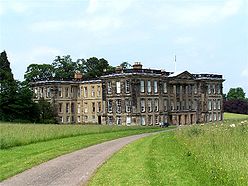
Harpur Baronets
Encyclopedia

Court of Common Pleas (England)
The Court of Common Pleas, or Common Bench, was a common law court in the English legal system that covered "common pleas"; actions between subject and subject, which did not concern the king. Created in the late 12th to early 13th century after splitting from the Exchequer of Pleas, the Common...
, of Swarkestone Hall
Swarkestone Hall Pavilion
Swarkestone Hall Pavilion also known as Swarkestone Stand and The Grandstand is a 17th Century Pavilion 200 metres north of the ruins of Swarkestone Hall, Swarkestone, Derbyshire. It is a Grade I listed building and may be found at...
, Swarkestone
Swarkestone
Swarkestone is a village and civil parish in Derbyshire, England.Swarkestone has a very old village church, a full cricket pitch, the Crewe and Harpur pub, a canal with locks, moorings and canalside tea-rooms...
, Derbyshire
Derbyshire
Derbyshire is a county in the East Midlands of England. A substantial portion of the Peak District National Park lies within Derbyshire. The northern part of Derbyshire overlaps with the Pennines, a famous chain of hills and mountains. The county contains within its boundary of approx...
. The fourth Baronet was High Sheriff of Derbyshire
High Sheriff of Derbyshire
This is a list of High Sheriffs of Derbyshire from 1568.The High Sheriff is the oldest secular office under the Crown. Formerly the High Sheriff was the principal law enforcement officer in the county but over the centuries most of the responsibilities associated with the post have been...
in 1702. He married Catherine, daughter of Thomas Crewe, 2nd Baron Crew (see Baron Crew
Baron Crew
Baron Crew, of Stene in the County of Northampton, was a title in the Peerage of England. It was created on 20 April 1661 for the politician John Crew. He was the son of Sir Thomas Crewe, Speaker of the House of Commons. Lord Crew was succeeded by his eldest son, the second Baron. He sat as Member...
). The fifth Baronet sat as Member of Parliament
Member of Parliament
A Member of Parliament is a representative of the voters to a :parliament. In many countries with bicameral parliaments, the term applies specifically to members of the lower house, as upper houses often have a different title, such as senate, and thus also have different titles for its members,...
for Worcester
Worcester (UK Parliament constituency)
Worcester is a borough constituency represented in the House of Commons of the Parliament of the United Kingdom. Since 1885 it has elected one Member of Parliament by the first past the post system of election; from 1295 to 1885 it elected two MPs....
and Tamworth
Tamworth (UK Parliament constituency)
Tamworth is a parliamentary constituency represented in the House of Commons of the Parliament of the United Kingdom. It elects one Member of Parliament by the first past the post system of election.- History :...
. The sixth Baronet was Member of Parliament for Derbyshire
Derbyshire (UK Parliament constituency)
Derbyshire is a former United Kingdom Parliamentary constituency. It was a constituency of the House of Commons of the Parliament of England then of the Parliament of Great Britain from 1707 to 1800 and of the Parliament of the United Kingdom from 1801 to 1832...
. The seventh Baronet assumed the additional surname of Crewe in 1807 in commemoration of his ancestry. The eighth Baronet sat as Member of Parliament for Derbyshire South
South Derbyshire (UK Parliament constituency)
-Elections in the 2000s:-Elections in the 1990s:"-Elections in the 1980s:-Elections in the 1940s:-References:...
. The ninth Baronet was High Sheriff of Derbyshire in 1853. The tenth Baronet was High Sheriff of Derbyshire in 1900. The title became extinct on his death in 1924.
The Derbyshire estate passed down on the female line and in 1949 was inherited by Charles Jenney, grandson of the last Baronet, who changed his name to Harpur-Crewe. Inheritance tax problems enforced the sale of the estate on his death in 1981 and in 1985 Calke Abbey
Calke Abbey
Calke Abbey is a Grade I listed country house near Ticknall, Derbyshire, England, in the care of the charitable National Trust.The site was an Augustinian priory from the 12th century until its dissolution by Henry VIII...
passed to the National Trust
National Trust for Places of Historic Interest or Natural Beauty
The National Trust for Places of Historic Interest or Natural Beauty, usually known as the National Trust, is a conservation organisation in England, Wales and Northern Ireland...
.
Harpur, later Harpur-Crewe Baronets, of Calke Abbey (1626)
- Sir Henry Harpur, 1st Baronet (1585-1638)
- Sir John Harpur, 2nd Baronet (1616-1669)
- Sir John Harpur, 3rd Baronet (1645-1681)
- Sir John Harpur, 4th Baronet (1679-1741)
- Sir Henry Harpur, 5th Baronet (1708-1748)
- Sir Henry Harpur, 6th BaronetSir Henry Harpur, 6th BaronetSir Henry Harpur, 6th Baronet was an English Tory politician who represented the constituency of Derbyshire.Harpur was the son of Sir Henry Harpur, 5th Baronet and Lady Caroline Manners, daughter of John Manners, 2nd Duke of Rutland. He succeeded his father to the Baronetcy in 1748. He lived at...
(1739-1789) - Sir Henry Harpur Crewe, 7th Baronet (1763-1819)
- Sir George Harpur Crewe, 8th BaronetSir George Harpur Crewe, 8th BaronetSir George Harpur Crewe, 8th Baronet was an English Tory politician who represented the constituency of South Derbyshire.-Biography:...
(1795-1844) - Sir John Harpur-Crewe, 9th Baronet (1824-1886)
- Sir Vauncey Harpur-Crewe, 10th Baronet (1846-1924)

